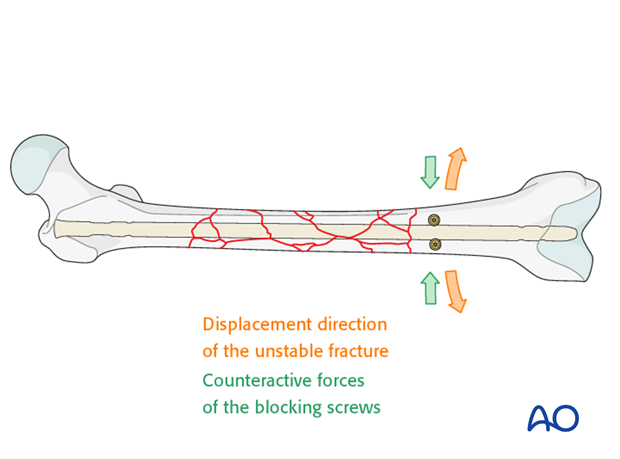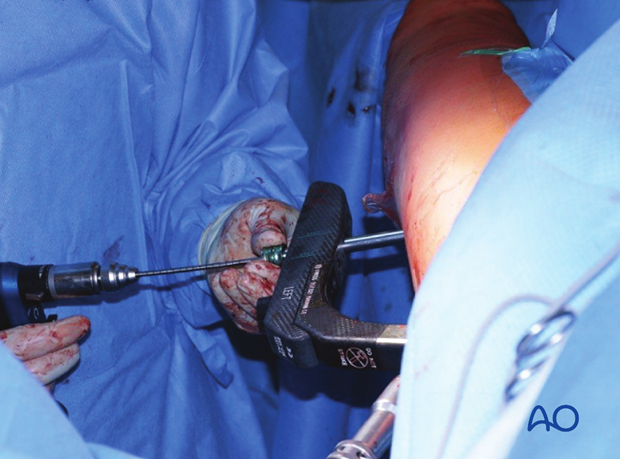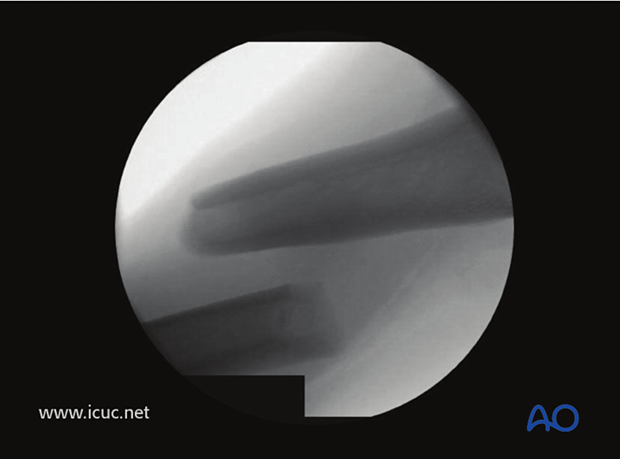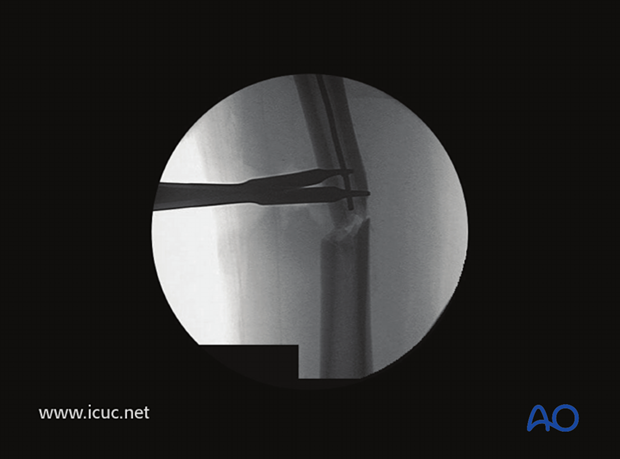Antegrade nailing
1. General considerations
Reamed versus unreamed nailing
In general, reamed nailing allows the use of larger diameter implants and may therefore provide greater initial stability. Some studies show a tendency towards less malunion and nonunion when reaming is performed. On the other hand, fat embolization is a concern and with the solid unreamed nails, the forces required to achieve nail torsion are higher. Most centers prefer reamed nailing as the standard procedure.
For bone graft while reaming, see Frequently Asked Questions about the Reamer Irrigator Aspirator system.
Note on illustrations
Throughout this treatment option illustrations of generic fracture patterns are shown, as four different types:
A) Unreduced fracture
B) Reduced fracture
C) Fracture reduced and fixed provisionally
D) Fracture fixed definitively

2. Patient preparation
The patient may be placed in one of the following positions:
3. Antegrade nailing approaches
The piriformis entry point is used for straight nails.
The trochanteric entry point is used for proximally curved nails.
4. Reduction
General considerations
In more proximal fractures, due to the pull of the iliopsoas muscle, the upper main fragment may be flexed and externally rotated, and the distal segment lies posteriorly due to gravity.
Reduction is performed under image intensification.
Several options for fracture reduction can be considered:
- Elevation of the distal fragment by use of a crutch.
- Lowering of the proximal fragment by external pressure from a mallet.
- A wrap around the femur.
- A Schanz screw inserted into one of the fragments.
- Use of a bone hook.
- (Manual reduction)
- Poller screws

Elevation of the distal fragment by use of a crutch
This option may only be used if the patient is on traction. A crutch is slid beneath the distal main fragment to elevate it to the level of the proximal fragment.

Lowering of the proximal fragment by external pressure from a mallet
Firm manual pressure is usually required to achieve fracture reduction.

A wrap around the femur
Based on the nature of the fracture, the wrap is usually placed around the larger fragment.

A Schanz screw inserted into one of the fragments
A monocortical Schanz screw (preferably 5 mm) can be helpful for providing direct control of the displaced fragments. It is superior to reduction maneuvers through the skin.

Bone hook
Direct reduction with a bone hook may be helpful for securing an anatomic alignment. Careful insertion and manipulation must be performed, to minimize soft-tissue trauma and to prevent injury to the femoral artery.

Reduction using a bone hook with minimal incision is advised.

Manual reduction
Manual reduction may be attempted, but radiation of the surgeon‘s hands may be unavoidable.
Guide wire insertion
A guide wire is advanced into the distal main fragment until it is about 5 mm proximal to the intercondylar notch. It is important that the guide wire be centered to prevent eccentric reaming and subsequent malposition of the nail, which can result in varus/valgus/antecurvatum/retrocurvatum malalignment.
Unreamed nailing does not require a guide wire. When unreamed nailing is performed, the nail is used as a reduction tool.

Guide wire inserted down the femur before reduction of femur shaft and nailing.

To ensure maintenance of alignment of the K-wire throughout the reaming process, it may be gently tapped to provide purchase in the cancellous subchondral bone. If this is not achieved, the guide wire may displace on removal and exchange of the reamers.

Teaching videos
AO teaching video: Femur - Shaft fractures - Intramedullary Nailing with the Antegrade Femoral Nail (AFN)
AO teaching video: Femur—Shaft fracture 32-B2 Intramedullary nailing with the Expert Lateral Femoral Nail (LFN)
5. Poller screw (blocking screw)
General considerations
The concept of a poller screw is based on the principle that the malalignment induced by oblique, proximal and distal fractures can be counteracted by the nail-directing effect of the screw. Therefore, its position should aim to counteract the displacement of the fracture. Most often it is therefore placed in the short side in the distal fragment. If there is a wide canal, two screws can be placed on either side of the path of the nail.
It is advisable to insert the poller screw prior to reaming, and in case of unreamed nailing, prior to nail insertion, to provide adequate contact between the nail and the screw. If the poller screw is inserted after reaming, the path of the nail is already set and the poller screw may not work. A small fracture screw or a locking screw can be used as a poller screw, depending on the local anatomy.
The reaming process in the presence of the poller screw must be performed very carefully in order not to harm the reamer tip.
The most frequent indication for poller screws is a proximal or distal oblique fracture which tends to shift when the axial knee blow technique is used to close any fracture gap, or when the patient is mobilized.
In these cases, prophylactic poller screws are very helpful.
See also:
Stedtfeld HW, Mittlmeier T, Landgraf P et al. The Logic and Clinical Applications of Blocking Screws. J. Bone Joint Surg. Am. 2004; 86-A Suppl 2:17-25.
Midshaft comminuted fractures
Poller screws are used according to the initial displacement and the size of the canal. In general, midshaft fractures tend to align better than more proximal or distal fractures and, therefore, the indication for poller screws is uncommon.

6. Determine nail length and diameter
Determine nail length via guide wire (only with reamed nailing)
The correct length of the nail is determined by comparing a second guide wire to the one that has been inserted. The correct placement of the guide wire in the distal canal should be assessed via image intensifier. Additionally, the second guide wire must be positioned in contact with the greater trochanter. This must be verified by image intensifier as well.

Radiographic ruler
Alternatively, a radiographic ruler may be used.
The tip of the ruler should be positioned in the center of the distal end of the femur. Nail length is determined by the position of piriformis fossa, not by the tip of the greater trochanter.

It is important to visualize the fracture zone by image intensifier to ensure that adequate restoration of femoral length has been achieved.

Nail diameter
It is important to measure the medullary diameter at the mid portion of the femur, which represents the narrowest segment of the medullary canal.
The inner cortical edge should touch with the inner numbered disk of the ruler aperture. In the illustration an inner cortical diameter of 14 mm is shown.

Consideration for special situations
In multifragmentary fractures, or in open fractures with bone loss, it is safer to perform preoperative planning on the uninjured leg. In bilateral femoral fractures, the less comminuted side should be used to determine the length and diameter of the nail.
7. Reaming
Insertion of reaming rod
After the tissue protector has been introduced, the reaming shaft, fitted with the first reamer head, is inserted over the guide wire. Usually reaming begins with a 9 mm medullary reamer.

Sequential reamer size increase
Reaming is performed in sequential steps by increments of 0.5 mm each.
As soon as chatter from cancellous bone can be felt and heard, the inner cortex has been reached. This may not be the case in segmental fractures or when severe comminution is present.
Adequate reaming must be performed to allow for smooth nail insertion. For example, for a nail width of 10 mm, drill bits of up to 10.5 or 11 mm diameter are used. If a very tight fit of the reamer can be detected before the desired reaming size is reached, one should consider using a smaller nail than previously planned.

Pitfall 1: Eccentric reaming
Eccentric reaming can cause weakening of the adjacent cortex which may interfere with healing or even cause a fatigue fracture.
Pitfall 2: Trapping of reamer by slow spinning
If the reamer becomes trapped while reaming, it must be gently removed by the most senior surgeon, because breakage of the reamer tip in this situation can be a devastating complication.
Pitfall 3: Heat necrosis by overaggressive reaming
Overaggressive reaming should be avoided because it may cause heat necrosis of the femoral canal. This applies especially for narrow midshaft canals (9 mm or less in diameter).
Pitfall 4: Rapid thrusting/systemic fat embolization
Care should be taken to use sharp reamers, to advance the reamers slowly, and to allow sufficient time between reaming steps for the intramedullary pressure to normalize. Rapid thrusting of the reamer may worsen the intramedullary pressure increase that is observed during nailing. This image demonstrates fat extrusion in a human cadaver specimen with a window in the proximal section.

This may cause pulmonary embolization of medullary fat, which in turn may lead to pulmonary dysfunction (lower image in the enlarged view shows an example of fat embolization through the right atrium).

Special situation: conversion from an external fixator to an intramedullary nail
Because the external fixator is still in place, the Schanz screws must be partially withdrawn to allow the guide wire, the reamers, and later the nail, to pass through. The external fixator is held in place by monocortical purchase to assure that the fracture remains stable. The external fixator also acts as a joystick for the reduction.

8. Nail insertion
Connecting handle to nail
The insertion handle is connected to the nail by the corresponding connecting screw. It is attached using the hexagonal screwdriver through the hole in the insertion handle. It is recommended that the nail be inserted manually and rotated about 90 degrees from its point of entry to its final orientation.

Introduction of nail
Under control with the image intensifier, the nail is pushed down as far as the fracture zone. After the driving cap has been fixed to the insertion handle, the nail is further advanced into the medullary cavity by gentle hammer blows, whilst verifying the position of the tip of the nail under the image intensifier.
In this intraoperative view, the nail is about to pass the fracture site in the intensifier image.

In this intraoperative view an unreamed nail is inserted and the external fixator is used as a joystick to help to reduce the fracture anatomically.

Once past the fracture, the nail is advanced by hand or by gentle hammer blows.

Passing the fracture zone
It is important that the tip of the nail does not become trapped in the distal main fragment because blow out fractures can occur. Each gentle hammer blow should advance the nail. Do not force the nail through a tight canal – if necessary, re-ream to another 0.5 mm diameter.
In many cases, the nail will help to align the fracture.

A solid nail (unreamed technique) passes the fracture site into the distal medullary canal.

Assessing proper nail insertion
The nail is then completely inserted. This is assessed by using an additional K-wire that marks the upper end of the nail.
Intraoperative photo of nail inserted with fracture reduced and mild distraction.

AP image of nail inserted in the proximal femur.

9. Nail locking
Purpose of locking
Locking was developed to provide and maintain rotational stability and length. It can also be used to finalize fracture reduction.
"Backslap" technique
This technique is used after locking of one segment. If the distal segment is locked first, a slotted hammer can be used to pull back the distal main fragment in a retrograde manner.
If the proximal segment is locked first, the traction can be released, and the distal fragment can be moved proximally by controlled axial blows to the knee.
Static locking
Simple spiral and simple oblique fractures are usually stabilized with static locking screws.

10. Distal locking
Verification of nail position
Before locking, the correct position of the nail and the rotation of the femur must be verified.
If no traction table is used (ie, using the freehand technique) the cable method may be used. In this approach, a line is drawn from the iliac spine across the patella to the cleft between the first and second toes. If rotation is correct, this line will pass over the mid line of the patella. The radiological landmarks of the center of the femoral head, the center of the knee and the center of the ankle joint should all be in line if the mechanical axis of the femur is correct.
Another method of assessing rotational reduction is to compare the cortical thickness above and below the fracture. If a shaft fracture is multifragmentary, the image intensifier cannot be used to assess the analogue cortical diameter on both sides of the fracture.

Distal aiming
For distal locking, the image intensifier is brought into a strict lateral position. The distal hole must be seen as a perfect circle and the tip of a scalpel is projected into the center of the hole.

This guides the stab incision down to the femoral cortex.

Screw insertion technique
The radiolucent drive helps to position the drill bit so that the locking screw can be properly inserted. While the locking hole is drilled, the assisting surgeon must prevent the lower extremity from moving in order not to miss the target hole. The length of the locking screw is determined, using the appropriate depth gauge. Then the locking screw is inserted.

If a radiolucent drive is not available, the projection of the tip of the drill bit should be placed as centrally as possible (see image). Start drilling but assess the position of the tip of the drill bit repeatedly, with the drill temporarily uncoupled.

Pearl: If the contact between the screw driver and the locking screw is lost, the screw may move within the soft tissue and become extremely hard to capture. To prevent this time-consuming complication, the locking screw should be lassoed with a strong absorbable suture.
Pitfall: If the screw holes are not perpendicular to the nail, the locking screw may become trapped and may not be advanced properly.

Second locking screw
The second locking screw is inserted into the distal locking hole. After distal locking, an axial blow to the knee region may be used to reduce any fracture distraction.
Alternatively, when distal locking is completed prior to proximal locking, a slotted hammer can be used to pull back the locked nail and the distal fragment.

Completed distal locking
The image shows the distal locking completed.

Pitfall: screw loosening
Care should be taken to capture the far cortex to prevent toggling when the patient is mobilized. This would lead to early loosening of the locking screw. In the image shown, the proximal locking screw is of correct length, but the distal one is marginally too short.

11. Intraoperative radiological assessment
Assessment of rotation
The profile of the lesser trochanter is compared with that of the contralateral leg (lesser trochanter shape sign).
Before positioning the patient, the profile of the lesser trochanter of the intact opposite side (patella facing anterior) is stored in the image intensifier.
The illustration shows the lesser trochanter of the intact opposite side.

Malrotation
In cases of malrotation, the lesser trochanter is of different profile when compared to that of the contralateral leg.
Care should be taken to assess rotation with the patella facing directly forwards.


Matching of the lesser trochanter shape
After distal locking, the correction is achieved by using the handle of the nail insertion device. Thereby the distal main fragment can be rotated in relation to the proximal main fragment.

Cortical step sign and diameter difference sign
The presence of considerable rotational deformity may be diagnosed by the difference in thickness of the cortices above and below the fracture zone.
The diameter difference sign is of use at levels where the bone cross section is oval rather than round. In cases of malrotation, the proximal and distal main fragments will appear to be of different diameters.

12. Proximal locking
Proximal aiming device
If proximal locking is performed before distal locking, it is important to verify the correct position of the distal end of the nail under the image intensifier, before the proximal aiming device is attached to the insertion handle.

Preparation for screw insertion
The sites of the skin and fascial incisions for the drill bit and locking screws may be determined after the drill sleeve assembly has been in the holes of the aiming device.
The length of the locking screws is read from the calibrated drill bit. The correct length is confirmed antero-posteriorly using the image intensifier. The insertion handle should not be removed until the correct placement of all the locking screws has been verified.

Drill sleeve to bone contact
The drill sleeve must be in close contact with the bone at all times since it is important for the measurement of the locking screws. Close contact is maintained by pressing down on the sleeve with the contralateral thumb.

Fluoroscopy of proximal locking of femoral nail.

Verification of locking screw placement
A final x-ray in two planes should be obtained in all cases in order to verify the exact locking screw placement.
Here showing the final x-rays of a fragmentary segmental fracture.


Special situation: associated femoral neck fracture
The system used for the ipsilateral femoral neck and shaft fracture must have the ability to biomechanically solve the midshaft femoral and femoral neck dilemma. This means that the nail must have at least two possibilities for screws into the femoral neck. Another option would be as shown in the diagram.

Special situation: segmental fracture with extension to the subtrochanteric region
In cases of segmental fractures with extension to the subtrochanteric region the standard femoral nail with multiple proximal locking screws may be used.

Special situation: extension of fracture to the lesser trochanter
When a dedicated cephalomedullary device is not available and the fracture configuration permits, a 130° antegrade locking option can be considered.

13. Insertion of end cap
An end cap may be used, depending on the final assessment of the nail length in relation to the tip of the greater trochanter.
The distance between the proximal end of the nail and the tip of the trochanter determines the appropriate length of the end cap, which is between zero and 20 mm, in 5 mm increments. The end cap is introduced using a hexagonal screwdriver.
The end cap is optional for the standard femoral nail.
Pitfall: The removal of the end cap may be very difficult if an exchange nailing is required. Bony overgrowth may require an extensive dissection of the greater trochanteric region. On the other hand, the end cap will have prevented tissue ingrowth and so, after its removal, the insertion of the extractor device is easier.

14. Wound closure and assessment of alignment
Wound closure
The procedure ends with the closure of the fascia and the skin as separate layers.

Assessment of alignment
Before the patient is moved from the fracture table, rotation of the leg is observed clinically and compared to the contralateral leg.
With the femur now stable, it is possible to perform a thorough examination of the knee joint to rule out additional ligamentous injuries.

15. Aftercare following antegrade intramedullary nailing of simple spiral or oblique fractures
Compartment syndrome and nerve injury
Close monitoring of the femoral compartment pressures should be carried out, especially during the first 48 hours, to rule out compartment syndrome.
Functional treatment
Unless there are other injuries or complications, mobilization may be started on postoperative day 1. Static quadriceps exercises with passive range of motion of the knee should be encouraged. Shortly afterwards special emphasis should be given on active knee and hip movement.
Weight bearing
Full weight bearing may be performed with crutches or a walker.
Follow-up
Wound healing should be assessed regularly on a short-term basis within the first two weeks. Subsequently 6 and 12-week follow-ups are usually performed. If the fracture healing is not adequate, removal of the static locking screw can be considered to achieve increased load transfer through the fracture site. Additional autogenous bone grafting may sometimes be required.
Implant removal
Implant removal is not mandatory and should be discussed with the patient if implant-related symptoms are troublesome.
16. Case
Preoperative images with ipsilateral femoral neck, femoral shaft, and distal femur condylar fracture in a 20-year-old patient.
This fracture combination can be extremely difficult to treat, and carries a high risk of delayed healing and late complications.

Intraoperative view of patient on fracture table.

Intraoperative fluoroscopic view of femoral neck fracture with a small amount of traction applied.

Midshaft fracture in femur, in traction but not reduced.

Insertion of initial T-handle reamer for nail placement.

Ball-tip guide wire at fracture site before fracture reduction.

It was not possible to achieve closed reduction of the shaft fracture.
A small incision was used to access the midshaft fracture.

Small Hohmann’s retractors were inserted to expose the fracture.

The incision was enlarged to allow a bone clamp to be placed on each of the main fragments. This allowed the fracture to be reduced so that it was possible to pass a ball tipped guide wire across the fracture site.

Reaming was performed over the guide wire.

A femoral nail with proximal cephalomedullary locking options is inserted.

Once the nail is inserted to appropriate length, the femoral neck fracture must be reduced and held with guide wires. This image shows the first guide wire being inserted through the lateral cortex.

Lateral image showing guide wire with fractured femoral neck. Slight distraction of the femoral neck can still be seen.

A second guide wire is inserted; note that the femoral neck fracture is still distracted.

Intraoperative image showing the first screw inserted into the femoral head.

Clinical intraoperative image showing proximal screw insertion into the femoral head using a jig.

Intraoperative image showing final screw placement.

Lateral intraoperative image of final reduction showing slight malreduction of the femoral neck, but now with minimal distraction.

Postoperative AP pelvis image.

Postoperative images showing complete fixation of the ipsilateral femoral neck, femoral shaft, and distal femur condylar fracture.

4 weeks postoperative X-ray showing good fracture alignment, but no callus.

17 weeks postoperative images showing initial femoral neck healing without displacement, but still minimal callus at the midshaft fracture.

39 weeks postoperative images show the femur completely healed.

1.5 years postoperative images show that both the femoral neck and shaft fractures are solidly united.














